Are drive-ins the future for cinema in this country? - Tony Earnshaw


Yet I can count my drive-in experiences on the fingers of one hand. On one finger, actually, because when it comes to genuine drive-ins straight out of vintage Americana, for me there has only been one.
I remember it well. The film playing was Bullitt. The location was Harewood House. And the place was packed with folk who, most likely, were soaking up the vibe for the very first time. Of course, it was an Anglicised version of a Stateside phenomenon. I was disappointed that we didn’t park our car next to a loudspeaker that could be perched on our window.
Advertisement
Hide AdAdvertisement
Hide AdAnd the Budweiser was overpriced. The film, however, was as timeless and fresh as it ever was. Thus my single, solitary drive-in can only be described as a treat. It was very much a one-off, and one has to wonder whether the organisers lost their shirts because I can’t believe that they made enough to cover their costs.
Flash-forward almost a quarter of a century and the drive-in, once a staple of Friday nights for 1950s youngsters from Pittsburgh to Fresno, could well prove to be the saviour of British cinema.
In these peculiar times it offers an opportunity for (reasonably) mass audiences to go to the movies. And within the confines of a car there is the opportunity to practice social distancing. Yet where once the infrastructure existed in the US – which also has the space to accommodate hundreds of audience vehicles on an average site – the UK would be starting from scratch.
And where the collective American memory can be sparked anew, in England it never really took root. There’s no opportunity for mums and dads to pass on tales from their courting days; if they went canoodling at the pictures, chances are it was in the back row of the local ABC.
Advertisement
Hide AdAdvertisement
Hide AdStill, all it takes is imagination – that and cash and an all-important buy-in from a cinema-going public that has been starved of big screen entertainment during the pandemic. Distributors might take some convincing. They won’t be keen to have their latest releases playing outside where anyone can copy them on an iPhone.
And so 50 years after it passed its zenith in the United States, the drive-in could transfer to the United Kingdom. It’s surely a desperate measure, but they are needed in desperate times.
The catch is in persuading punters to give up the comfort of the multiplex for car seats and windscreens and over-priced beer, although it’s still likely to be cheaper than at most multi-screen venues…